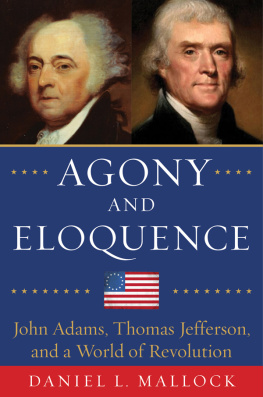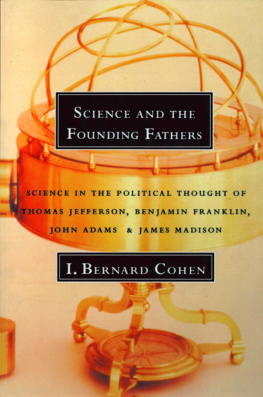ADAMS VS. JEFFERSON
ALSO BY JOHN FERLING
A Leap in the Dark: The Struggle to Create the American Republic
Setting the World Ablaze: Washington, Adams, Jefferson,
and the American Revolution
John Adams: A Life
Struggle for a Continent: The Wars of Early America
The First of Men: A Life of George Washington
A Wilderness of Miseries: War and Warriors in Early America
The Loyalist Mind: Joseph Galloway and the American Revolution

PIVOTAL MOMENTS
IN AMERICAN HISTORY
Series Editors
David Hackett Fischer
James M. McPherson
Books in this series examine large historical problems through the lens of one particular event. Each volume gives attention to the experience of ordinary people, to deep historical processes, and to structural change in society. At the same time, these works examine the fundamental role of contingency in history and the importance of choices made by individual actors. In this way, the series seeks to combine new approaches in historical scholarship with the age-old idea of history as a narrative art.
James T. Patterson
Brown v. Board of Education:
A Civil Rights Milestone and Its Troubled Legacy
Maury Klein
Rainbows End: The Crash of 1929
James McPherson
Crossroads of Freedom: The Battle of Antietam
Glenn C. Altschuler
All Shook Up: How Rock n Roll Changed America
David Hackett Fischer
Washingtons Crossing
ADAMS vs. JEFFERSON
The Tumultuous Election of 1800
JOHN FERLING


Oxford New York
Auckland Bangkok Buenos Aires Cape Town Chennai
Dar es Salaam Delhi Hong Kong Istanbul Karachi Kolkata
Kuala Lumpur Madrid Melbourne Mexico City Mumbai Nairobi
So Paulo Shanghai Taipei Tokyo Toronto
Copyright 2004 by John Ferling
Published by Oxford University Press, Inc.
198 Madison Avenue, New York, New York 10016
www.oup.com
Oxford is a registered trademark of Oxford University Press
All rights reserved. No part of this publication may be reproduced,
stored in a retrieval system, or transmitted, in any form or by any means,
electronic, mechanical, photocopying, recording, or otherwise,
without the prior permission of Oxford University Press.
Library of Congress Cataloging-in-Publication Data
Ferling, John E.
Adams vs. Jefferson: the tumultuous election of 1800/
by John Ferling.
p. cm. (Pivotal moments in American history)
ISBN 0-19-516771-6
1. PresidentsUnited StatesElection1800. 2. Jefferson, Thomas,
17431826. 3. Adams, John, 17351826. 4. United StatesPolitics and
government17971801. I. Title: Adams versus Jefferson. II. Title.
III. Series.
E330.F47 2004
324.973044dc22
2004007851
1 3 5 7 9 8 6 4 2
Printed in the United States of America
on acid-free paper
To the faculty and staff
of the Irvine S. Ingram Library
for years of assistance
with countless projects
Contents
Editors Note
ON ANY SHORT LIST of pivotal moments in American history, the election of 1800 will always have a central place. The winner, Thomas Jefferson, called it the Revolution of 1800. Not all historians have shared his judgment, but the more we learn about this event, the more revolutionary it appears.
Jefferson believed that it was mainly a revolution in the principles of our government, and truly it was so. The campaign of 1800 was a collision of three republican ideas: the oligarchic republic of Alexander Hamilton and the High Federalists, the balanced republic of John Adams (a balance between the few and the many), and the representative republic of Jefferson and Madison (in our terms, a democratic republic). Ironically, the tribunes of the democratic republic in 1800 were rich and well-born men of greater wealth than Adams and Hamilton. That would be so in many American generations.
The election of 1800 was also part of a structural revolution in American politics. The victorious party led a process of democratization in the abolition of property qualifications, the formation of closer ties between representatives and constituents, the development of party organization, and the growth of popular campaigning.
In all of these ways, the election of 1800 was not merely a revolution in political principles but also a deep change from one historical process to the next. During the decade of the 1790s, the American system had been moving in the direction of an oligarchic republic. In the elections of 1798, High Federalists made sweeping gains through the southern states as well as in the north, a consequence of the quasi-war with France. That movement was stopped with great courage and conviction by John Adams in 1799 and its momentum reversed in the election of 1800.
The voting in that year became a pivotal event in other ways. This was a realigning election, which established a new ruling coalition in New York, Pennsylvania, the southern and the western states. The Jeffersonian coalition had been unable to control the national government in the 1790s. It would dominate American politics for a quarter-century, from 1801 to 1825.
The contest that followed the election was also critical in its consequences. With great difficulty, Jeffersonians and Federalists established a precedent for the peaceful transfer of power between parties who detested one another. They affirmed the legitimacy of Americas Constitutional system, which would fail only once in the next two centuries, during the slavery crisis. Many modern republics have gone a different way. One South American republic suffered more than 170 coups and revolutions in less than 170 years. The election of 1800 was a pivotal moment for political stability in the United States, a vital factor in economic growth, social development, and cultural identity. The election of 1800 was a pivotal event in all of these ways.
It was also a very close-run thing. A shift of merely five electoral votes would have reversed the result. The outcome might have been different if Adams had not decided to send a peace mission to France, if Hamilton had not decided to campaign against him, if Madison and Jefferson had acted in other ways, if Burr had chosen differently.
John Ferling tells this deeply interesting story in a graceful and fluent narrative that centers on these extraordinary men and the choices that they made. Rarely in American history did such a tightly centered event have such sweeping consequences for this great republic.
David Hackett Fischer
James M. McPherson
Illustrations and Maps
Illustrations
)
. Watercolor on ivory by Charles Fraser. (Courtesy of the Gibbes Museum of Art/Carolina Art Association, Charleston, S.C.)
. Watercolor (detail) by Nicholas King. (Courtesy of the Library of Congress, Prints and Photographs Division, Washington, D.C.)
. Oil painting by John Trumbull, completed in 1820. (Courtesy of the Yale University Art Gallery, Trumbull Collection, New Haven, Conn.)
. Portrait (detail) by Mather Brown. (Courtesy of the Boston Athenum, Boston, Mass.)
. Portrait (detail) by Charles Willson Peale, about 1791. (Courtesy of Independence National Historical Park, Philadelphia, Penn.)
Next page








